The route of the 2020 Tour de France is out and it’s mountainous with mountain stages galore and more summit finishes than ever. Here’s a closer look at the stages and tomorrow we’ll look more closely at some of the details, themes and more.
The start in Nice is a known quantity for months but it’s still worth emphasising the mountainous opening weekend. Stages 1 and 2 share roads often used for the final stages of Paris-Nice and if these make a hectic finale, imagine sending a larger Tour de France peloton down these twisty roads with a yellow jersey waiting at the finish. Stage 2 includes two 15km climbs in Col de Colmiane and the Col de Turini and either is enough to decide Paris-Nice, having both of them is bold for an opener. Stage 3 is a reverse of a Paris-Nice stage with Nice to Sisteron via the Route Napoleon and the first chance for the sprinters.
Stage 4 and the first summit finish. Via some mountain passes the Tour returns to Orcières-Merlette after a 31 year absence when Steven Rooks won, but it’s better known for its first appearance in 1971 when Luis Ocaña attacked on the first climb of the day and then went solo to win by six minutes on the second rider and eight minutes on Eddy Merckx, this was the year he looked to have the better of Merckx only to crash out later on. Back to the future and the risk is that such an early mountain finish establishes a hierarchy to the race too soon but at 7km at 7% it’s nothing scary, the hope must be that it weeds out anyone bluffing about their condition. Stage 5 is for the sprinters but with an uphill drag to the line, a tilt to Peter Sagan.
Stage 6 is a summit finish of sorts on Mont Aigoual. Tackled via the south side and the Col de la Lusette – and not the west from Meyruis as featured in Tim Krabbé’s novel The Rider – it’s the Col de la Lusette thatis the main difficulty with 4km at 7-8% before an awkward 14km false flat section to Mont Aigoual. Stage 7 should be for the sprinters again as they go to Lavaur on the similar exposed roads that saw the race split on the way to Albi last July.

Stage 8 and the first day in the Pyrenees, the Col de Menté is scenic – Luis Ocaña, mentioned above, crashed out here in 1971 – and the Port de Balès is hard before the regular Peyresourde climb and a quick descent to Loudenvielle, it’s a vanilla start to the mountains.
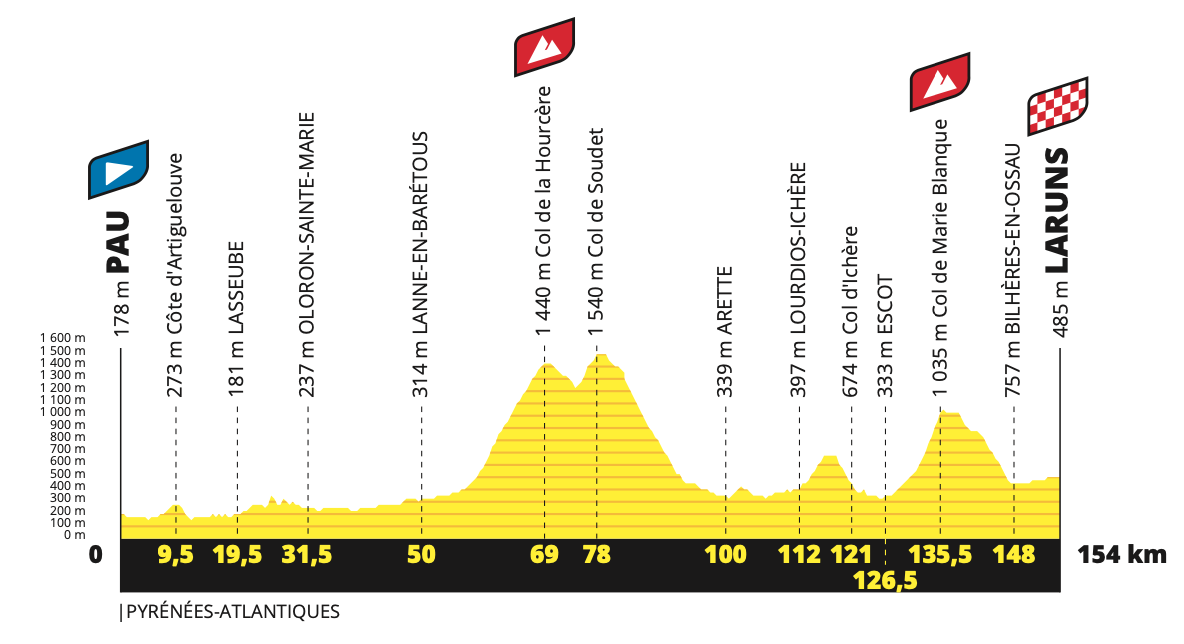
Stage 9 is the garage version of a Pyrenean stage. No Tourmalet, Aubisque or Soulor, the only certainty to cling to is a visit to Pau for the start. Then comes Hourcère, Soudet and Marie Blanque, the latter climbed via its steep side, a long ramp.
A rest day and then Stages 10 and 11 are likely sprint days, the first is a coastal affair between two islands so watch out for the wind but it’s as flat as a salt pan. The next day it’s inland to Poitiers, a city surrounded by marshland. Stage 12 is the longest stage of the race and at 218km “the shortest ever longest stage”. There’s nostalgic vibe as the route goes via Saint Léonard-de-Noblat, home of Raymond Poulidor, and Linards, the adopted village of legendary L’Equipe columnist Antoine Blondin, before lumpy roads passing the Suc au May climb for a finish in the tiny village of Sarran, population 275, long the fiefdom of the recently deceased President Jacques Chirac.
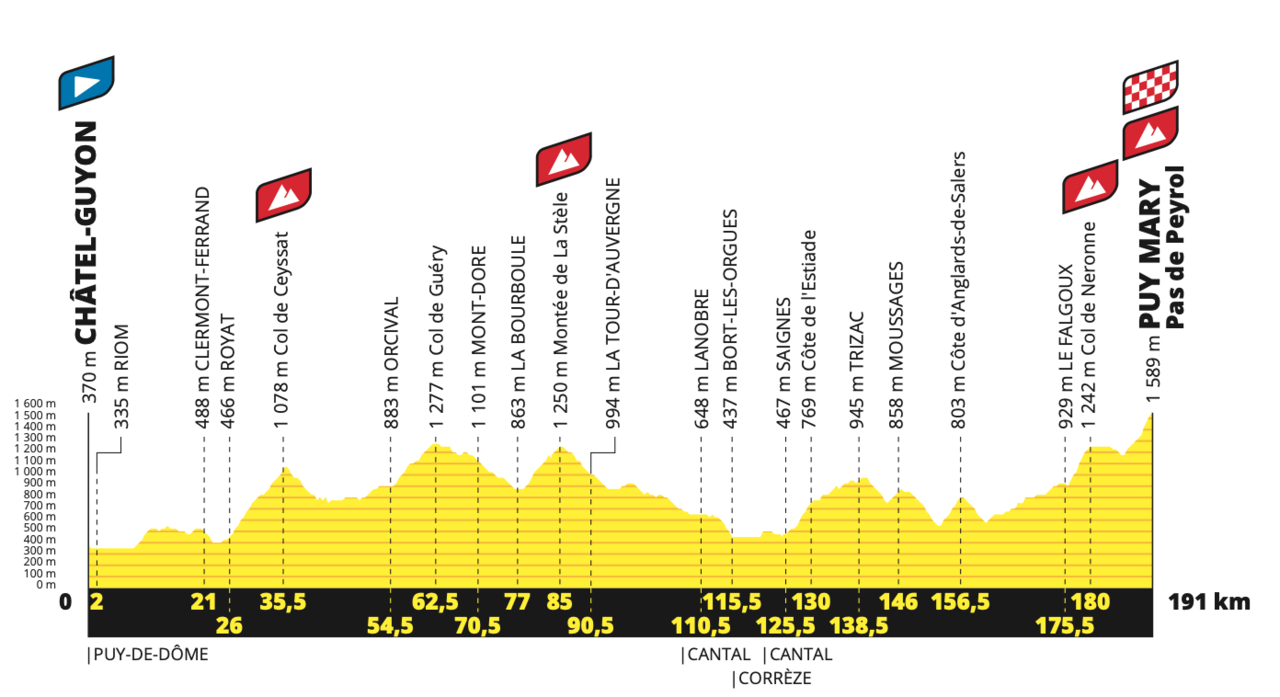
Stage 13 is a summit finish on the Puy Mary, a scenic climb. It’s in the mountains and constantly up and down, the stage should rack up 4,000m of vertical gain but only the finish is hard with the final three kilometres above 10%.
Stage 14 heads from Clermont-Ferrand to Lyon. Where and how is a mystery for now, the full route isn’t out. Either way there’s a fun finish that tackles the hills in the city, roads used in the Dauphiné when John Degenkolb took a stage win in the Dauphiné in 2011 and the same race’s prologue in 2014, a final 15km described by Christian Prudhomme as “à la Milan-Sanremo” because of the repeat sharp climbs and twisty descents, this is a rare urban flourish for the Tour which is otherwise hyper rural.
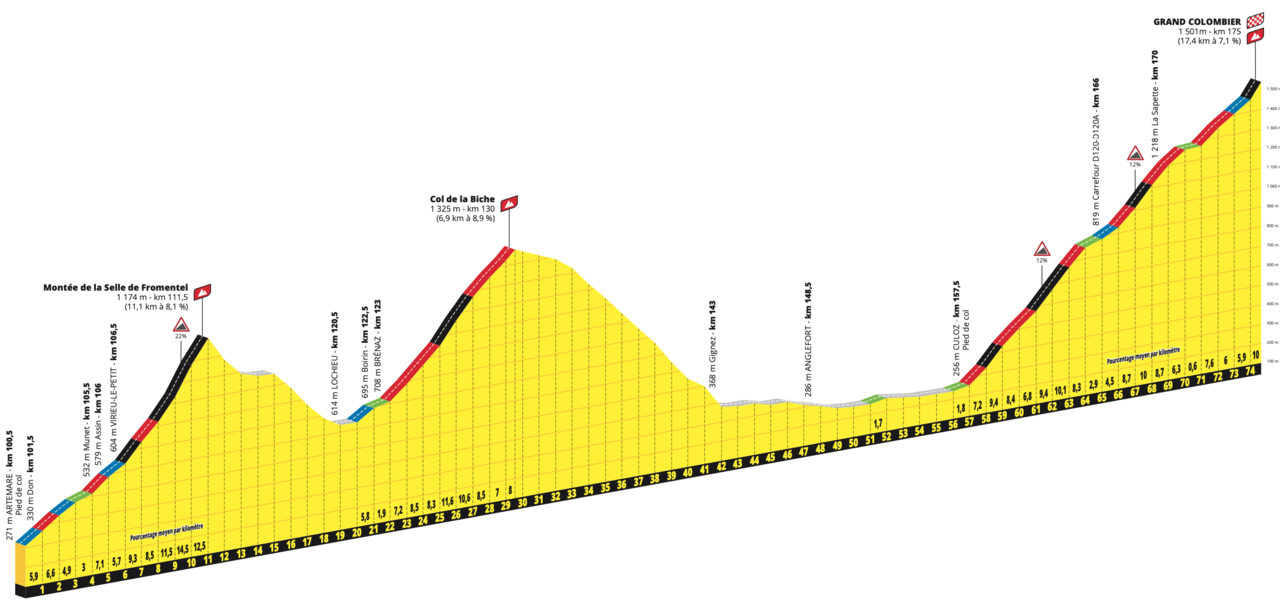
Stage 15 heads into the Jura mountains, a day to breakout the compact chainsets. For years a staple of the Tour de l’Ain, the Tour de France ignored the Grand Colombier until 2012. Now for 2020 it’ll be a summit finish. There are different roads to the top and it’s partially climbed mid-stage before crossing over to the tough Col de la Biche, then a scary descent and a valley section leading to the Grand Colombier from Culoz, it’s a very hard climb, irregular and with gradients regularly over 10%.
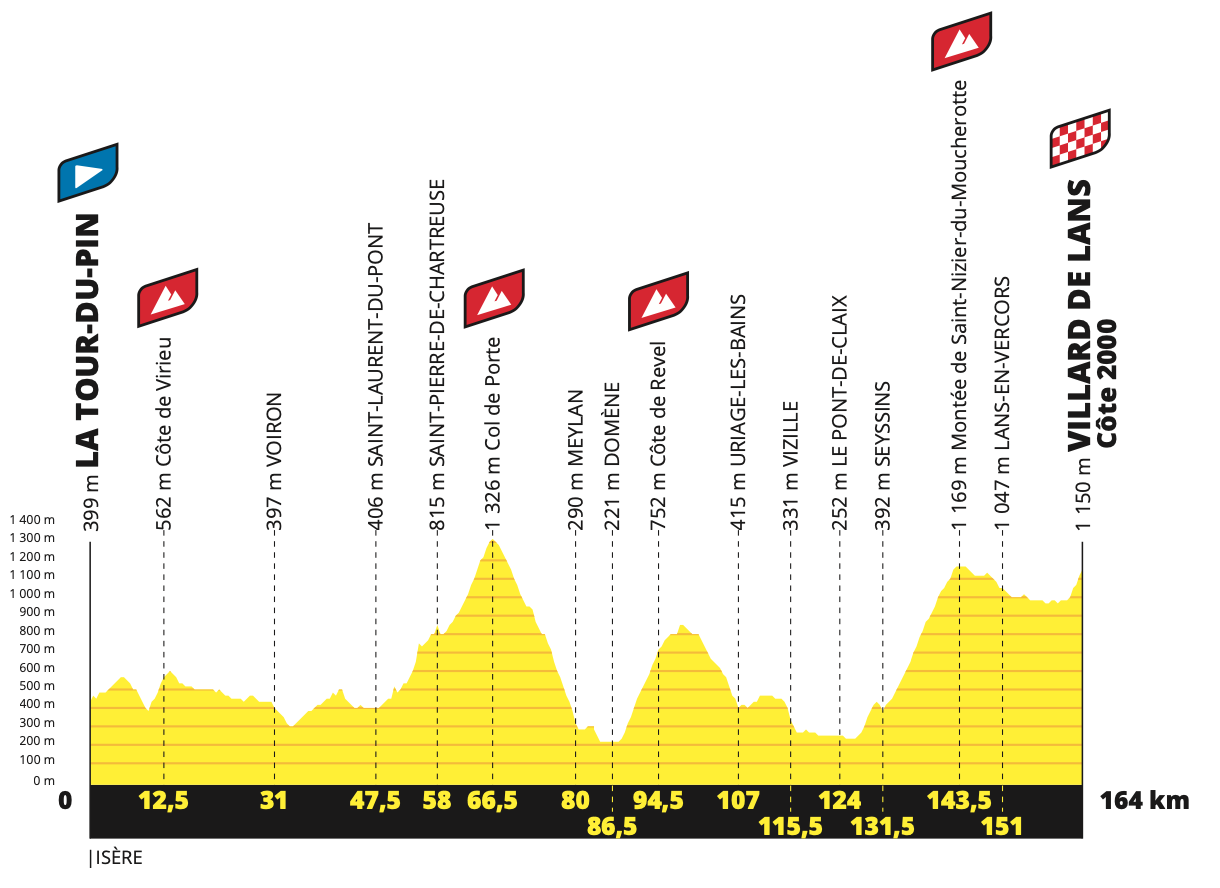
Stage 16 and it’s the Chartreuse range and the Col de Porte before the Vercors and a finish above Villard de Lans, it’s the same finale as used in the 2015 Critérium du Dauphiné at the end of an epic stage won by Rui Costa.
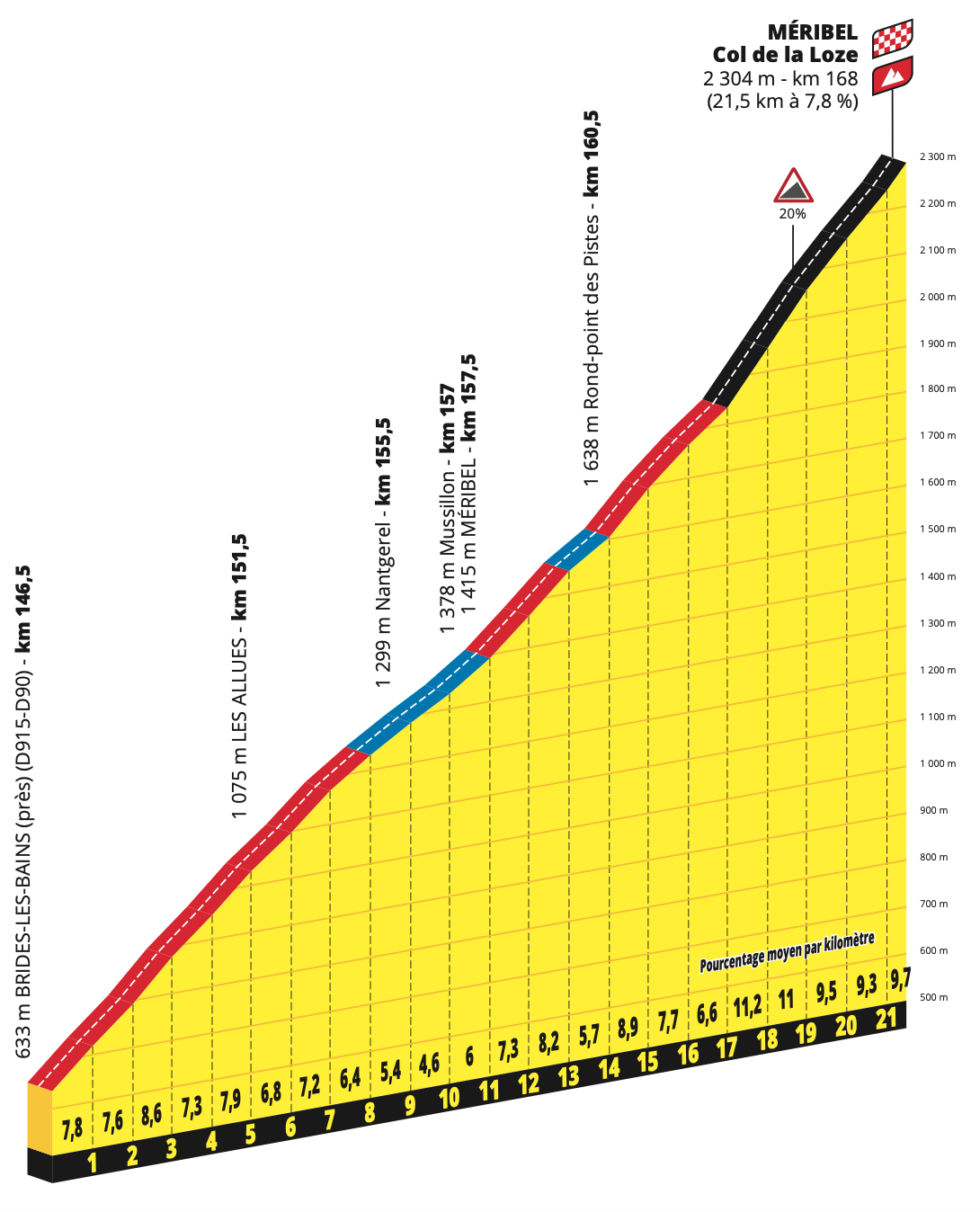
Stage 17 is the Queen Stage. It’s 168km and the original plan was to climb Grand Cucheron at the start but the finish is so hard they decided to skip it. First comes the Col de la Madeleine, a staple of the Tour but for the first time climbed via a sideroad that’s more narrow and irregular before joining the main road near the pass. A regular descent and then some valley roads and then a new climb, the Col de la Loze. Often a “new” climb is a conceit for a road that’s simply been ignored for decades, like the Grand Colombier, here the Loze is a brand new road that was only paved this year to connect the swank ski resorts of Courchevel and Méribel. It’s reserved for cyclists and pedestrians only and perhaps because of this it’s not an engineered road with even gradients, the joke goes that they just poured the tarmac down the mountain. Listed as 21.5km long but this includes the ordinary road to Méribel, 15km at an average of 6.5% and then comes the new section of 6km at 10% average but will wildly changing gradients, one minute flat and the next 20%. At 2304m would be a big test, this irregular road makes it that bit harder.
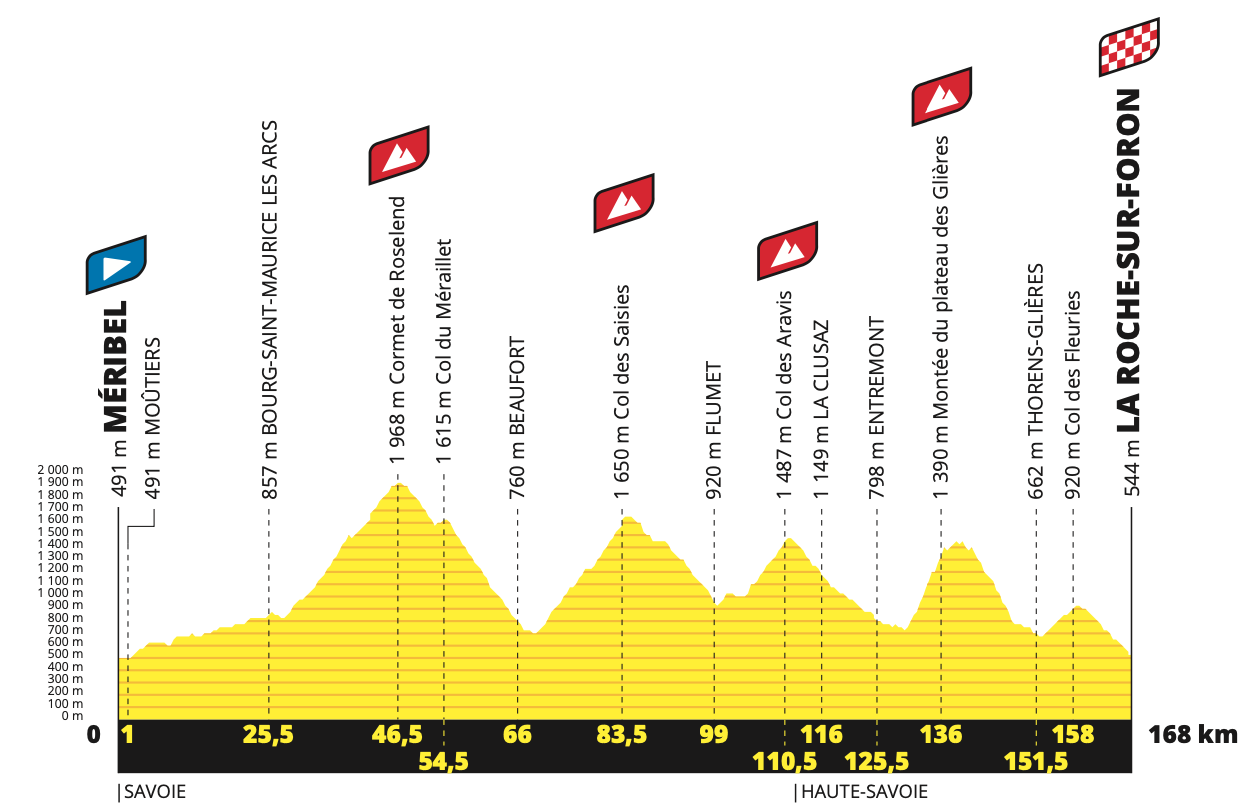
Stage 18 is another big day in the Alps, first crossing the Cormet de Roselend – which was closed because of a landslide last July – before the familiar Saisies-Aravis combo of picture-postcard scenery with its pastures and chalets. The Plateau des Glières is back and one of the hardest climbs in France. There are longer climbs, there are steeper climbs but there might not be another road that is as steep for as long in France. It’s chased by a short gravel section across the plateau – which will get sections of the media more excited than the long climb to get there – and technical descent before some lumpy roads and a drop to the finish. Stage 19 crosses the Bresse plains to Champagnole and is one for the sprinters again.
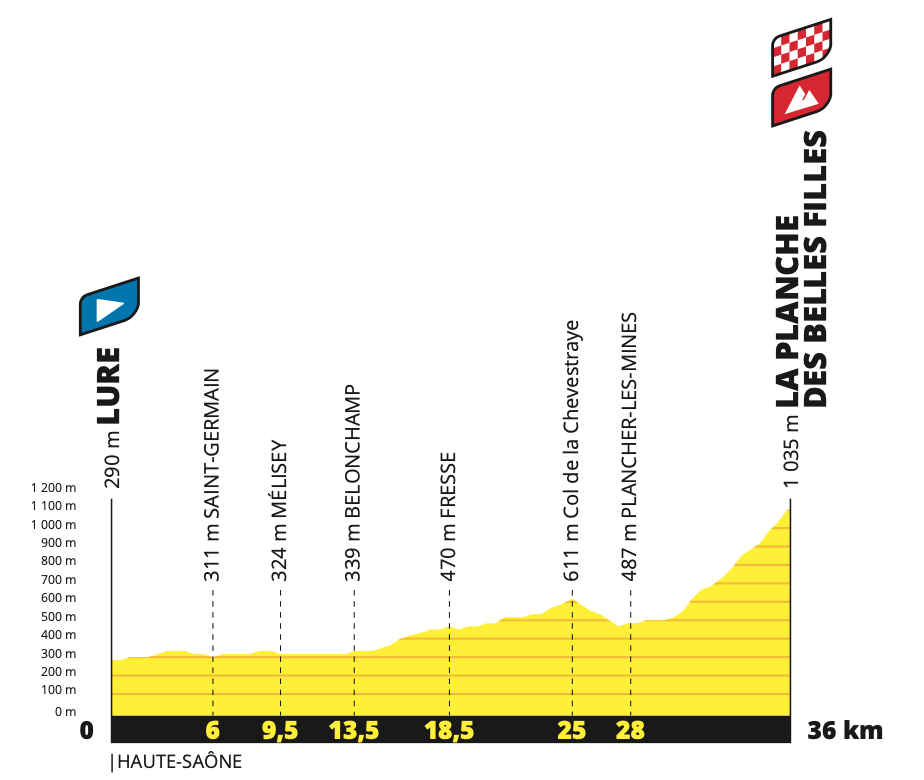
Stage 20 is a 36km time trial which is short compared to history but long compared to recent editions and starts in Lure and crosses the plains before heading to the hills and then the climb of the Planche des Belles Filles, this time only as far as the tarmac goes, there’s no gravel top. Stage 21 is the familiar Champs Elysées stage.
- Six summit finishes if we count Mont Aigoual, more than ever
- 10 mountain stages
- One time trial, 36km
- Only three flat stages, five probably sprint stages, possibly seven
- Like 2019 there will be time bonuses at the finish and on select climbs
Overall
It’s the prototype Christian Prudhomme route, the deliberate decision to exploit France’s hilly geography at the expense of its flatter regions in order to have a race route made for television. Still it’s not revolutionary, there’s 50% more solo time trial kilometres than last year and 2.5 times more than 2015 while the vogue for short mountain stages is paused, gone are the 60km or 120km mountain dashes we’ve seen in recent years. Still it’s a massif route where the climbs keep on coming, from the nervous opener in Nice to the backroads of the Pyrenees, the Auvergne volcanoes and the Jurassic ramps that’s before the final week in the Alps with the Col de la Loze as the big rendez-vous. There are as few dull days as possible and the hope must be that the few time trial kilometres keep the contenders within seconds of each other until the final weekend.

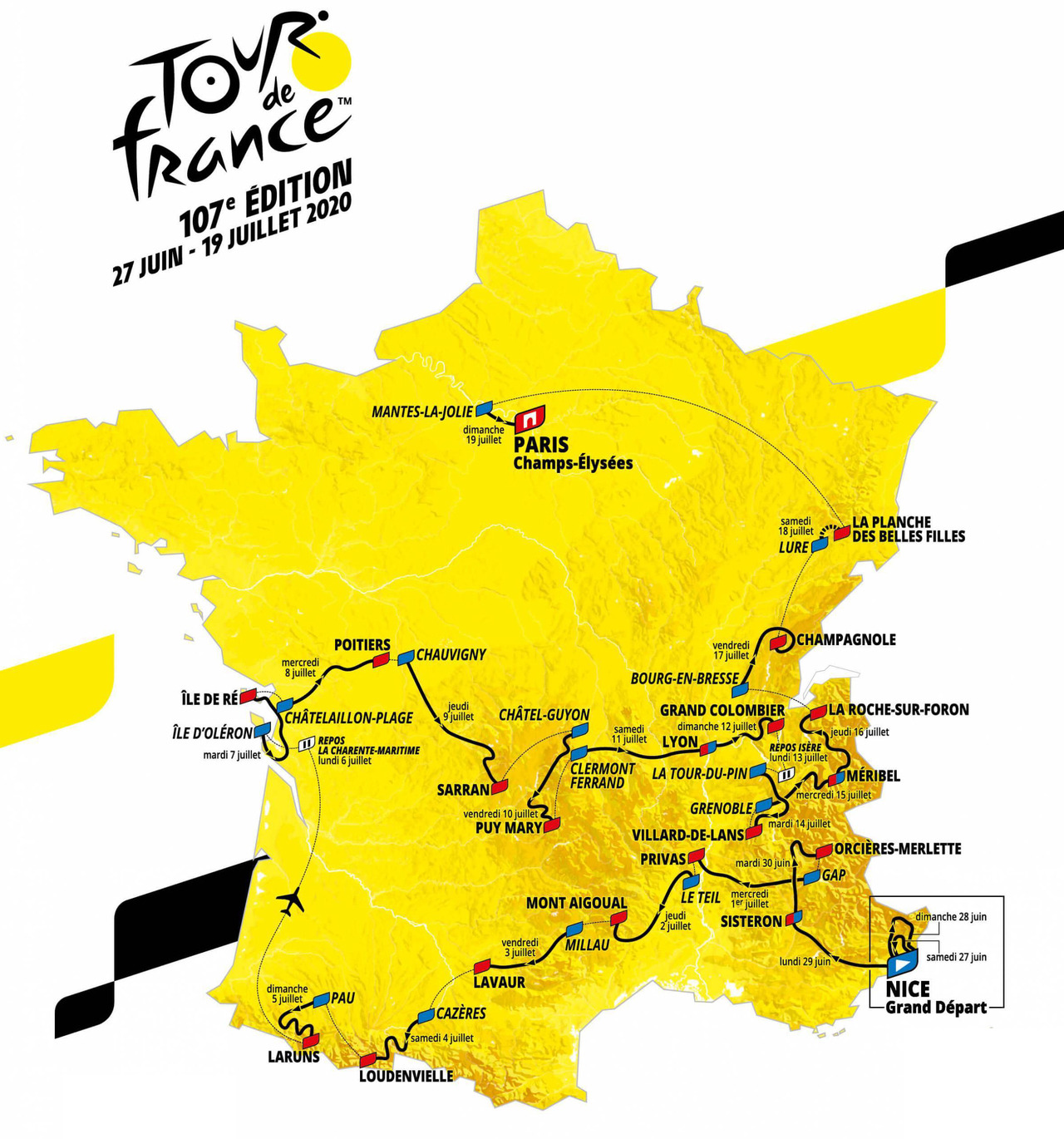
As a resident of Nice, I’m bloody loving this!
However, I must try to be balanced and say that this appears to be a very experimental route, for the shape of the map, the choice of climbs and the on-again-off-again way it tackles the mountains (not just the two big ranges at the weekends). If it produces a great tour then all bets are off for what future routes will look like. The chances are that it’s being different just for different’s sake.
I can’t find the quote now but next year’s route is supposed to be more of a back to normal/a reset course with more obvious climbs and time trials… but each route is shaped by events and the thinking is the Tour will keep trying to use the various mountain ranges and skip as much of the flat parts as it can, 2020 does this a lot, maybe it’s less next year but still always more than the past.
Thanks for that information. It’d be great to have the two versions back-to-back as a way to compare.
I am new to the sport, but have taken a liking to the tactical game of catch-the-breakaway and sprint finishes. These stages are difficult to set up in Le Tour? Bunch sprints are less-and-less popular with the big ego sprinters going away?
You’re not wrong Yoda. Basically it is more exciting when there is a selection (a small number of riders) who are vying for the win. Each will chance their hand, and eventually a winner becomes clear. Trouble is that riders/teams are controlling this process which pundits decry as boring.
Although there is the drama of catching the break, with team radios and updates on gaps the inevitability of a bunch sprint has made it meaningless to watch the 3-4 hrs that proceed the final 2-3 minutes of such a stage.
I enjoy sprint finishes, and I miss them sometimes because they are part of the GT culture. To get the highs you must also have lows – by creating high levels of attrition from making them race hard (sprint days give GC riders something of a rest) the riders struggle to reach the highest highs that lead to targeted performances on epic mountain stages….or so the theory goes.
Riding punch drunk is not great, but the spirit of the race in its inception was that it should be so hard only one rider should finish.
Beauty is in the eye of the beholder, so we (the commenters) argue endlessly on whether these sorts of things are good or bad. Mostly the fans are always left disappointed because the race never meets our rose tinted view of whichever previous tour was our favourite.
As a frequent visitor to Nice (did the Transvésubienne MTB race 3 times), I never understood why the Tour does not visit this region more often. There seem to be endless possibilities for really interesting race routes over there.
Traffic mainly, the Tour demands closed roads and it’ll cause gridlock, even inland on the climbs the closed road are a real headache for normally unseen logistical questions, eg what happens if an ambulance or a fire engine is needed in village but can’t get through because the road is closed because of the caravan etc.
What InRng says is true. Nice is squeezed between hills and sea (like a mini-Genova) and this means major routes into and out of town are at a premium.
If the tour used other towns along the coast, it wouldn’t be much better either, and that’s for the second reason: mass tourism. The whole region is packed all summer with many people who aren’t interested in seeing their quaint market square replaced with a ‘village départ’. Town councils also don’t really need the publicity down here.
‘Why did Nice apply for a Grand Départ then?’ you might well ask. I think it’s because our mayor has an ego and ambition the size of Armstrong’s, and he’s up for election next year!
Personally I prefer more high mountains, its what makes the Tour and Giro different from many other races, seems like very little racing over 2000m. I suspect the hope is a dramatic showdown on Belle Filles, though do wonder if the first 28km of somewhat flatter course will seriously dent some rider’s chances.
PS the graphic for Belles Filles is in twice, suspect the first one should be the Glieres stage
fixed now 🙂
The 28km of flatter course is certainly going to ruining whatever was the plan, this route while it doesn’t look like it, it heavy favours TT’rs that minimise time in climbs, Roglic and TD, specily the lack of high mountains helps those riders. Froome if back into shape is also a good bet, Bernal I’m not so sure he can build a gap big enough to survive the TT
Can’t lie, love this.
Excited already.
Love the retweet you put out INRNG of ‘Vuelta de France’.
Vuelta and Giro have been the best Tours for too long, look forward to seeing whether the early and constant climbs can ruffle the feathers of the big teams. Hopefully last year was a starter for a 2020 main course… *(fingers crossed for Pinot already)
To be honest, even if Ineos and Jumbo steam roller everyone, I’m fine with a slug-out between the two, it might even allow a third player to come to the fore as with the Giro this year…
If people are fearful of the best coming to the fore too early… this doesn’t really worry me either, as now you basically just wait for those you expect to rise to the top and they usually do, so what’s the difference if that comes earlier? I see it as a positive, we might get another Simon Yates ’18 Giro or even Alaph this year – with someone burning bright and lighting up the Tour with a will he/won’t he hold on narrative.
My only fear is people wait for the TT, although in saying that, the ’18 Giro TT forced Yates to go for broke so maybe it’ll be similar? Although guess it’s an uphill TT…
Overall though, can’t wait.
I think the fear of “the best coming to the fore too early” is repeats of recent Tours when Froome has taken yellow and then never lost it, the contest for the yellow jersey dries up but this time it’ll be harder to control anyway.
“There are longer climbs, there are steeper climbs but there might not be another road that is as steep for as long in France.” There is this climb close to Saint-Jean-Pied-de-Port which has the same average percentages as the Plateau de Glieres, but it’s 1,2 kilometers longer. Only problem is that the road to the top of the Pic de Beillurti, as it is called, isn’t wide and so are the other roads from the top to the various valleys surrounding it
One to visit some day. The Tour too would like to visit the Basque region, it tried a bit in 2017 but had to scale back plans. There’s talk of a start in Bilbao and it’s the tough either side of the border that could be interesting as well.
Interesting route. Something for everyone I’d say. Climbs for the climbers, TT for the TTers, and enough mixed terrain and downhill finishes to keep Alaphilippe in the action if not in the yellow jersey. Though I have to say that final TT looks ideal for Roglic, not that it specifically doesn’t suit Dumoulin or Froome. The lack of a team time trial or any sort of early flat section seems to suit those who are big fish in an otherwise relatively weak team over the super teams I would say.
Think of the ‘super’ teams that Ineos and Jumbo Visma could each put out though?
It’ll be interesting to see which of the two announces their squads first – does the other then counter?
And, as you say, there’s a little bit of something for everyone – so where does that leave the Giro?
The two first Grand Tours have been yin and yang to each other in the last couple of years at least.
Does this tough Tour mean the Giro will be / has to be TT-friendly for instance?
I worded that wrong. Maybe it just doesn’t specifically disadvantage lone wolves.
The Giro should just do it’s own thing. If it’s going to be ying to the Tours yang throw in a proper decent TT, some sprint stages (sprinters are in danger of becoming redundant) and high altitude climbs.
I doubt that the 2020 Giro will be one for the sprinters, after this year’s edition where they had almost two whole weeks worth of winnable stages.
Lotto-J team presentation in December will shed some light on their team for the Giro/Tour, they suggested in Dutch media. With this much climbing it’s even more interesting for them because it might – at least in theory – add to the chances of Kruijswijk.
Every year seems to be a variation on the theme of “more climbing than ever before”, whether measured by number of peaks or altitude or whatever.
And cutting TTs can make for conservative racing because a poor TTer no longer feels that he has “nothing to lose” by going kamikaze. (Would Formigal have happened if Quintana wasn’t worried about the TT?)
Maybe it’s the shortening days, but my gut feeling is “everything changes but everything stays the same”.
I will study the details but i’ll start to give my appreciation for the lack of a team time trial.
Finally want to go and see the race on the ground. Any suggestions on which stage/stages to watch please?
The Planche des Belles Filles is promising as you can pick a spot where they’ll ride past slowly one by one… but access is going to be hard work.
The Grand Colombier could be the best picnic spot as there are places you can sit and spend two hours on a day when there’s no race on because the view is so good near the hairpins and on the Tour day you can see the race approaching from far below.
Otherwise the Vercors plateau and Villard de Lans could be a good spot, you can see the race (or rather get there early, see the caravan, wait, the race flashes past) as you can then visit the start the next day in Grenoble, plus there’s great cycling around. Grenoble itself is a nice place if you’re in the right part of town, it’s a student town surrounded by giant peaks and cliffs; the wrong part and your car could be used as a makeshift firework.
http://inrng.com/2018/01/tour-de-france-spectator-tips/ For more spectator tips
This year, access to the Planche was actually pretty good, with Navettes carrying spectators from pre-designated parking spaces to the ski station (where there was the all important big screen). Alternatively, the route meeting the valley road just below Plancher-Les-Mines means that it is an easy park/ride or walk (around 10k from the junction to the top). Opportunities to watch on the climb itself are a bit limited due to the vertiginous verges, but on the plus side, shade is good.
I love the Port de Bales. it’s very scenic and there are some fine spots to watch, especially near the top.
I love the mountain stages like everyone else, but feel slightly wistful at the lack of wet northern stages and windy flat ones. Most of the unpredictable upsets in recent years have come in the wind and the rain, haven’t they?
I kind of thought this as well, the map pretty much saws France in half horizontally except for the Paris finale. “Tour de 1/2 France”? “1/2 Tour de France”? They can’t go everywhere of course, but the map is kind of jarring to look at IMHO.
Ecky- as to what RCS might have in-store for us in May 2020, I doubt they pay much attention to whatever the Grand Boucle may have in the works – they have plenty of other considerations to deal with.
I’ll push on with my earlier comments. By taking the road up so much you end up with teams that are so climbing specific you end up with stalemates. Riders unable to attack, teams in control and a race failing to spark.
Give teams flat stages, and chances of a break so that the big contenders can recover, the powder can dry out and the fireworks beat the disappointment of a damp squib.
yes, you need flat stages/cobbles/TTT to force GC oriented teams to bring some non-climbers so as to avoid mountain trains stifling attacks. those stages might not be exciting in and of themselves but they enable excitement in the mountain stages. the alternative would be to reduce team sizes.
on a related note, it will be interesting to see what the jumbo squad is like next year
When I first started watching the Tour, and up until fairly recently, the first week was flat. Pan flat. The only thing to break up the monotony of Cipollini stage wins would be a massive TT, individual or team. At first glance we’d all say that’s boring. I worry a bit that with this sort of all action route where even the token flat stages might be windy where pushing the sport down a route where doping becomes a necessity. A GC man has to be able to go deep every day, over a seemingly endless succession of climbs compared to back in the day when they spent a third of the race just making sure they stayed upright. Just a thought.
They dope for the 100m in athletics, it’s under 10 seconds and not a mountain pass in sight. Being less flippant the toughness of an event can crack some riders mentally, there’s one or two autobiographies touching on this, but there’s more with cultural factors, entourage, detection probability, incentives etc.
We pretty much know that if you want to dope you can, and as long as your doctor doesn’t get busted by his local Police force for fraud or tax evasion then you’ll probably get away with it.
If Operation Anderlass teaches us anything, it’s that you still have to dope to be a bit more than
mediocre in the peloton.
If Operation Aderlass teaches us anything it is that some people will still make up any old shit to justify their prejudices.
While the individual TT is longer than last year the lack of Team TT means almost the same length overall and being a third uphill, this TT gives a very different composition to the overall race.
Only the Meribel stage is high mountains and summit finish by the looks of it.
Looks a very interesting route – not sure who this favours yet!
With the Olympics how many big names will decide to skip the Tour to have a shot to win gold.
Some might still want to ride the Tour in the same way people have ridden the Vuelta or they can ride the Tour and then win San Sebastian but this will mean going easy in the final week of the Tour. Others won’t though, eg Nibali is already talking about the Giro. For me you can ride the Tour but the real issue for Tokyo could be the heat, it might be a pleasant 27°C but could equally be 38°C and with a humidity the peloton won’t have felt before all season but this is also a logistical challenge for the team, being ready to hand up a lot of cold drinks etc.
Who remembers any Gold Medalist from any Olympics? Win Le Tour and you become a GOD.
The importance of the Olympics varies by sport and by country too, eg track cycling’s pinnacle is an Olympic medal, the same for swimming etc but for road cycling, tennis or golf it’s a good career achievement but the sport doesn’t revolve around it. What we could see is riders of contention on GC really shutting it down in the final week of the Tour, maybe trying on one stage but not fighting every day in the breakaway (à la Bardet, Quintana or Simon Yates this year) and if the weather is bad they might go home.
Not so much a Tour de France, but rather a Tour de Vichy France. What a sinister coincidence 80 years later.
Those who forget history are doomed to repeat it.
This year’s route could have been equally appropriate, coming into the country from the direction of Belgium and finishing with a parade on the Champs Elysee.
It goes outside of that division at times too, both on the east and west. Nice to see them returning to the Plateau des Glières too.
Dude, gimme a break. So the whole south region of France was responsible for nazi collaboration, while everone in the north was innocent of collaborating and the Vichy guys didn’t came from the North?
This is BS on so many levels…
Uh, no-one said what you’re saying was said.
Regarding your comment about stage 5 being a tilt to Sagan, I’ll be surprised if he’s there. I think he’s openly suggested for a few years that he’d like to do the Giro, and with the green jersey record now in hand, what’s the point of slogging for three hard weeks to hopefully win that one stage?
And while that means skipping California (and Tour de Suisse?), he has nothing left to prove at either of these. He holds the record for most stage wins at both, and having stage wins at all three GTs would be a bigger addition to his legacy. Plus he loves Italy, and he doesn’t seem to get much joy at the TdF anymore. This year it seemed almost a slog, chasing jersey points instead of racing on instinct.
Yup, I suspect that you are correct. With the shortage of TT km and the brief gap until Tokyo, I would imagine that Dumoulin and other rouler-type GC men will also follow the same logic and ride the Giro instead? You could almost predict a fight between Roglic and TD to be the one kept out of the Tour team!
Sources in Slovakia, and his recent interviews, suggest, that Giro is not on the cards for him next year. Like or not, Tour is the biggest race, and his sponsors will want him there. The route is not favourable for pure sprinters, and with so much climbing it could even be doubtful, if Ackermann can finish, so Sagan is still a better bet for Bora. Whether he goes for green again, or just chases stage wins, and hepls Buchmann on the flat is another matter.
Published on October 3rd:
Welke? Hoe ziet volgend seizoen eruit?
,,Het draait om de klassiekers en de Tour, net als dit jaar.”
https://www.ad.nl/wielrennen/sagan-misschien-was-van-der-poel-wel-te-gemotiveerd-op-wk~a3ea5277/?referrer=https://www.google.com/url?sa=t&rct=j&q=&esrc=s&source=web&cd=1&ved=2ahUKEwioybWT1aDlAhXVi1wKHer_AokQFjAAegQIAxAB&url=https%3A%2F%2Fwww.ad.nl%2Fwielrennen%2Fsagan-misschien-was-van-der-poel-wel-te-gemotiveerd-op-wk~a3ea5277%2F&usg=AOvVaw0s38q79lGJbc0Kkj0azNfR
Thanks for the links. I’ve known it was very important to Specialized, and I assume Bora and Hansgrohe, for him to be at the Tour of California, so that’s one strike against the Giro. And as you say, the TdF is massively important, and while Ackermann is probably a better bet to win multiple stages, Sagan going for the green, and finishing in the top 5 in 9-10 stages, gets much more attention. In this year’s race he seemed to be just doing what was expected, with only a few moments of seeming to race with joy, and that’s not why I love to watch him race.
Agree. It was an “accountant” Sagan that we saw last July. But I think, and it is also the impression he gave in interviews both home and abroad, that he really wanted to get this job with number 7 green done, and therefore took minimal risks. Remember his crash and almost non-finish in 2018 Tour. I do believe, we could see the old spontaneous Sagan again next year.
I think the Big-S already sells enough bikes in Italy to Italians – the f–king things are everywhere! Wonder if the Big-T will have any luck selling theirs in Italy once Vincenzo Nibali is riding one next year? For every one of those I see here I see 10 of the Big-S brand, both in the north and in the south
All those luscious steel bikes in Italy, and they’re all buying CF made in China!? Oh, the humanity! I look forward to a trip to Italy to add another Tommasini to my small stable.
Irio and family will tell you they sell next-to-nothing when it comes to steel bikes here in Italy. They all go to other places in the world where they appreciate steel. Here it’s just the epoca (as in L’Eroica) folks. The day Super Mario quipped “Cannondale! Best bike!” I think hundreds of torches were turned off in shops all over Italy and the tubes and lugs left to rust while the shops turned to people who used to make lawn furniture to weld up something in aluminum.
When carbon fiber came ’round, few wanted to work with the filthy stuff or invest in what it took to make bikes out of it – so more frame shops closed as the work went to China. Ironically, Super Mario’s been sort of leading the charge to Made-in-Italy carbon, spending some big money on advertising here. Dunno if it’s working, for every one of his bikes, I see 20-30 from the Big-S.
Good point, he’s been a fixture but there’s talk he might do the Giro. As well as a change, there’s also appearance money, we know RCS pay big to have star riders take part and it means it could give Ackermann a go at the Tour de France so a double win for Bora-Hansgrohe.
He also gave an interview in Italy recently, where he reiterated he wanted to do the Giro at one point, but not next year,
“Stage 6 is a summit finish of sorts on Mont Aigoual. Tackled via the south side and the Col de la Lusette – and not the west from Meyruis as featured in Tim Krabbé’s novel The Rider”
Ah, that’s a shame. Love that book and I’ve always wondered what the climb looks like in real life. I suppose it’s never going to look as epic as Krabbe makes it sound, so maybe for the better.
There are people going to ride the roads from the book, I think even Tim Krabbé has joined in tours. It’s a nice part of France with some great roads but remote, which is part of the charm but it makes access to places like Meyrueis awkward.
All the talk of never-ending pressure and day-after-day climbing building up to a TT makes me wonder if the ’18 Giro won’t prove to be the most significant GT of recent years. I don’t know if the drama of that occasion will be repeated, but it is perhaps the model.